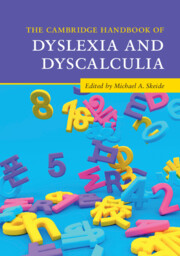Book contents
- The Cambridge Handbook of Dyslexia and Dyscalculia
- The Cambridge Handbook of Dyslexia and Dyscalculia
- Copyright page
- Contents
- Figures and Tables
- Contributors
- Acknowledgements
- General Introduction
- Part I Theoretical Frameworks and Computational Models
- Part II Cognitive Profiles and Behavioural Manifestations
- Part III Genetic and Environmental Influences
- Part IV Neurodevelopmental Foundations
- Part V Gender, Ethnicity, and Socioeconomic Background
- Part VI Cultural Unity and Diversity
- 15 Cross-Cultural Unity and Diversity of Dyslexia
- 16 Cross-Cultural Unity and Diversity of Dyscalculia
- Summary: Cultural Unity and Diversity
- Part VII Early Prediction
- Part VIII Intervention and Compensation
- Part IX Best Practice – Diagnostics and Prevention
- Part X Best Practice – Schooling and Educational Policy
- General Summary
- References
- Index
- References
16 - Cross-Cultural Unity and Diversity of Dyscalculia
from Part VI - Cultural Unity and Diversity
Published online by Cambridge University Press: 28 July 2022
- The Cambridge Handbook of Dyslexia and Dyscalculia
- The Cambridge Handbook of Dyslexia and Dyscalculia
- Copyright page
- Contents
- Figures and Tables
- Contributors
- Acknowledgements
- General Introduction
- Part I Theoretical Frameworks and Computational Models
- Part II Cognitive Profiles and Behavioural Manifestations
- Part III Genetic and Environmental Influences
- Part IV Neurodevelopmental Foundations
- Part V Gender, Ethnicity, and Socioeconomic Background
- Part VI Cultural Unity and Diversity
- 15 Cross-Cultural Unity and Diversity of Dyslexia
- 16 Cross-Cultural Unity and Diversity of Dyscalculia
- Summary: Cultural Unity and Diversity
- Part VII Early Prediction
- Part VIII Intervention and Compensation
- Part IX Best Practice – Diagnostics and Prevention
- Part X Best Practice – Schooling and Educational Policy
- General Summary
- References
- Index
- References
Summary
At an international conference in China, we were asked by a non-Chinese colleague: ‘Since Chinese students are already so good at mathematics, why are you studying dyscalculia?’ Advantages in the development of early mathematics ability have been generally documented in favour of Asian Pacific countries/regions including China, Japan, Korea, and Singapore (e.g., Miller et al. 2005; Leung 2014). However, this advantage does not translate to an ‘immunity’ from problems related to maths learning in children. Problems in arithmetic (termed dyscalculia) that are encountered in most western countries are found with equal prevalences in Asian Pacific countries/regions. Thus, the work we do in China along with other research is still important for understanding dyscalculia in a universal context.
- Type
- Chapter
- Information
- The Cambridge Handbook of Dyslexia and Dyscalculia , pp. 282 - 299Publisher: Cambridge University PressPrint publication year: 2022
References
Suggestions for Further Reading
- 1
- Cited by

